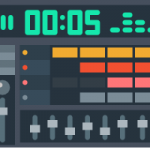目次
5. Contexts and Cognition
Yes, that’s the point. Some (Jazz people) cinically say “Oh, this is nothing special. You can find ton of these in jazz”.
However, what a short-sighted comment it is! As you somehow notice, the thing is much more complicated, far deeper than it looks.
①Cultural Perspective
The first thing you cannot miss is the cultural perspective — Such a strange chord is adored by J-pop.
Looking at Trap music, oriental scales called “maqām” are used frequently.
Some may say “Wow recent Trap music is interesting. They mix themselves with Arabic music”. And who on earth answers to this, “Oh, this is nothing special. You can find ton of these in Arabic music”? That’s utterly off the point.
EDM and Arabic Music, which never seem to have affinity each other, somehow fit perfectly and give us new kind of sound. And if we look closer, there rises an assumption like: “EDM loves pitchbend and maqām uses quarter tones. That could be why the two go along with well.” And these studies may open the new sonic world.
The same is true of Blackadder Chord. A super-jazzy chord falls in love with J-pop. It is this strange combination that we find intriguing.
②Cognitive Perspective
The second is rather important : This chord gives us insight about what we often overlook when thinking of music theory.
Let’s recall the ones categorized in “Half Dim Type”, especially IIIblk or VIIblk.
- IIm7V7IIIblkVI7
Interestingly, they don’t have much scent of Aug when compared to I+/IV.
If you interpret IIIblk as “Slashed Chord Type”, the upper triad is either II+,IV+ or
VII+ but to none of them are we familiar in popular music.
So I suppose: How strongly a Blk evokes Aug quality depends on how much you remember its original Aug chord. Let me perform a small experiment to confirm this.
- IIm7V7III
VI7IIm7V7IΔ9I+
The example above is a chord progression without Blk. Through these songs your ears learn and get used to the sound of III and I+.
Then one day you happen to hear this:
- IIm7V7IIIblkVI7IIm7V7IΔ9
IVblk
Compare how you feel when you hear IIIblk and IVblk. The former sounds a bit closer to Half Dim while the latter a bit to Aug, aren’t they? (YMMV tho.)
Imaginary Quality
Blk being still stranger to your ears, your brain at first gets struck by its sound. It then automatically looks up your “mind library” and returns the best possible result, causing each Blk to taste slightly different to ears.
This is soooooooo much interesting because their intervalic structure is identical. What it suggests is that Your memory affects how a chord sounds to you.
Have you ever experienced this? : The song starting with power chords, you think it a sad, minor-key song, suddenly turns out to be major-key as other intervals are revealed. After recognizing the actual key, you can never replicate the very first impression you had of that song.
The case above is something related to this. Your brain spontaneously fills what’s missing there and sculpture the imaginary chord quality.
This leads us to further study: The necessity of cognitive psychology in music theory.
Quadruple Contexts
Albeit it’s scarcely put on the table, it cannot be denied that cognitive psychology, besides math and physics, has a lot to do with music.
Let’s make a hypothesis : The reason why ♯IVblk is the easiest one to use is that it is supported by the largest number of contexts.
So far we’ve analyzed Blk chords by its type ( wholetone / slashed chord / tension chord ), but now let’s reverse lookup: Analyze Blk chords by its root and see how many contexts it may have.
| Rt | I | ♭II | II | ♭III | III | IV | ♯IV | V | ♭VI | VI | ♭VII | VII |
|---|---|---|---|---|---|---|---|---|---|---|---|---|
| ②-1 | – | ★ | – | ★ | – | – | ★ | – | ★ | – | ★ | – |
| ②-2 | – | – | – | ★ | – | – | ★ | – | – | – | ★ | – |
| ③-1 | ★ | ★ | ★ | ☆ | ★ | ☆ | ☆ | ★ | ☆ | ★ | ☆ | ★ |
| ③-2 | – | – | ★ | – | ★ | – | ★ | – | – | – | – | ★ |
②-1:Transitional / ②-2 Aug with Tritone Flipped Bass / ③-1 Dom9 / ③-2 Half Dim
★:Strong / ☆:Medium / -:Weak or none
Let me explain. For example, ②-2 column in I row is marked as [-]. This means “However we try to interpret Iblk as ♯IVaug/I, it’s unnatural because we’re not at all familiar to ♯IVaug and cannot feel the scent of Aug chord. Instead, it should be interpret as ③-1 tension chord”.
[☆:Medium] is a mark for “Tritone Sub of Secondary Dominants”. True they’re common in Jazz, but not common in popular music. Hence not “Strong” but “Medium” context.From this list you can clearly see that ♯IV is supported most strongly, by all 4 contexts. and 5 if you count Wholetone Scale! This is extraordinary. Most chords have only single context, or double at most.
♯IV bass passing between V-IV is fairly common (②-1). So is Iaug→IV progression (②-2), so is ♯IVø (③-2), and ♯IV9 too (③-1, not strong tho).
Isn’t it this “quadruple contexts” that makes ♯IVblk the easiest to use?
Opposite Instance
And vice versa. Iblk, for example, has only single context; ③-1 Dominant 9th.
I tried using Iblk and actually it was quite hard to make it work, at least not as easy as ♯IVblk.
- IVΔ7III7VIm7Iblk
This is what I eventually made. In spite of our great acquaintance with I7, it doesn’t fit much. Part of the reason for it would be its rack of contexts.
It’s damn easy to close discussion by simply asserting that “Blk = domi9(+11)omit3”. But this verdict never explains why ♯IVblk is easier than Iblk, nor why we feel “the scent of Aug”, ignoring its root.
As I mentioned above, your experience affect how a chord sounds to you. Current music theory seems to put little importance on these cognitive perspectives. Blackadder Chord, though unexpectedly, does throw a stone at this point.
The thesis “Multiplex-Contexts”
Some people seem to be stuck in the thought that you have to identify the parent scale of a chord when you “analyze” music, in the thought that each Blk instance has to be either slashed chord or tension chord, its quality to be either major or minor, and only either view must be right.
But the truth is : It need not necessarily be either. It can be both, or it can be neither.
The ANS(Available Note Scale) Theory, the most common system among current music theories, has its origin in Jazz improvisation, inevitably sets its direction like: “A chord is derived from a scale. They represent each other and by thinking this way, we can make clear on which scale we play ad-lib.”
But when it comes to composing, there actually is no need of clarifying all the intervals behind a chord.
You can easily fall into the trap of thinking that the duty of music theory is to make music “clear”, to make clear chord qualities, parent scales, available tensions and so on.
But viewing differently, you notice that something “unclear” is not bad. On the contrary, it could be a key to the new music realm — where a chord feels different to each listener, depending on their condition or experience and every interpretation is right, and that is exactly intended by the composer.
Blackadder Chords could be a key to the paradigm shift for music theory!
Utilize Multiplex-Context
Let me show you some examples using Multiplex-Context techniques.
This starts from repetitions of C and C+. On measure 8 it goes into Fblk and progress to Bm7!
And taking it as IIm, it starts 2-5-1-4 progression in A major key.
This is a rather interesting example in which Fblk goes to BΔ7 and taking it as IV, it starts 4-5-1-6 progression in F♯ major key. It’s modulation tritone away. Nonetheless, it sounds super smooth!
Blk as a pivot chord. Pivot chord itself is a very common technique, but in both cases Blk plays an intelligent trick : On entrance he disguises himself an Aug chord, while on exit he pretends to be a Dominant Seventh chord.
I carefully controlled the balance of chord tones and other intervals in order to gradually weaken the scent of Aug, transforming it gradually from “Slashed Chord Type” into “Dominant 9th Type”, which end up as solid Domi9 with the appearance of A#, the M3rd interval for F#blk. Only Multiplex-Context chords can perform such chameleon-like strategy.
This is beyond what current music theory deals with. This “context metamorphosis” is of great use for modulation. I reckon you can travel almost anywhere by way of Blk!
These Multiplex-Context technique must be applicable to other intervalic structure than RtM2+4m7, though I haven’t found any yet.
As to the Name
After all, it became obvious that “Blackadder Chord” has too many contexts to be explained in a single line.
So if you use the term “Blackadder Chord”, it would be smart to use it as a general name including all these types, rather than to assert that “Blk is Domi9(-5)”, “Blk comes from Whole Tone Scale”, or anything like that.
If you want to make it clear, you should simply use the existing chord names. Or would it be interesting that you call it Blk if you intentionally make it unclear?
Some say “No you don’t need a new name because there’s nothing new at all”. But I think the chord fairly deserve a name, in view of what it truly casts over the music theory world. Moreover, I’d like to give respect to Joshua, who has eagerly studied J-Pop and found this remarkable usage of this chord. People never know how difficult it is to “connect the dots”, but I do!
 Mr. Joshua Taipale
Mr. Joshua TaipaleSo I’m gonna keep using the term “Blackadder Chord”, just like an asteroid whose name’s given by its finder😉




